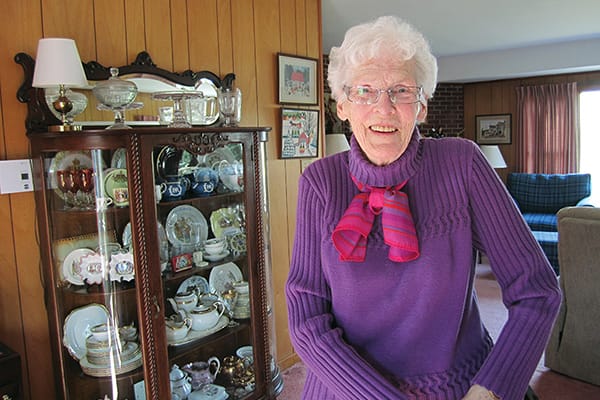POSITIVE AGEING is the buzz message of the decade. It’s about keeping a positive attitude about getting older, feeling good about yourself, and engaging in life fully. Younger years are divided into three phases: childhood, adolescence, and adulthood. Many moons ago I was told that one’s later years were also divided into three parts: the Go-Go, Slow-Go, and No-Go phases.
Earlier this year I met an amazing powerhouse of a woman, Clara Jefferson, who in her 80s is certainly in the Go-Go phase! I met her at a unique Valentine’s Day gathering where we brought photos of our weddings for perusal by the others—we giggled about the hair and dress styles and complemented each other on our beauty as young people.
Truth be known we are all much more beautiful now with the patina of time and experience etched on our faces and bodies!
Clara perused my album and whooped that she knew my first husband, who had been a neighbour of hers before I knew him. We spent some time that evening talking about good old times with George. Our connection to him cemented our connection to each other.
Clara is a true-blue East Coaster, or more specifically, an Annapolis Valley gal. She was born and raised in Wolfville, NS, obtained a B.Sc. in Home Economics at Acadia University, and pursued her career in various Upper Canadian and US locations. A master’s at Cornell University, in New York, with a major in Foods and minor in Education, prepared her for what most East Coasters dream about—a return to the home front. Acadia University was waiting for her with a position on faculty. Clara had completed the circle of leaving home and returning. But more than Acadia was waiting—so was her childhood sweetheart, Raymond Jefferson. They had 52 years together, both teaching in Wolfville.
If you have ever lived away from the Atlantic Provinces you will know how obsessed you become to return to your roots. We seem to need the saltwater running through our veins, we need to be surrounded by the culture and humour of our people—we need to be home.
After meeting Clara in February I had to wait almost a month before we could meet again—she was busy, busy! She had darted down to Florida for a week, then over to California to visit an old school chum. And she was busy hither and yon giving talks about her rare (100+ years) and vintage (up to 100 years) cookbook collection.

Given her career in dietetics, it is no surprise that Clara developed a fascination for old cookbooks. It began when she was given a copy of Mrs Beeton’s Book of Household Management, originally published in 1861. Clara has a 1906 edition. Inside the book is the inscription “I Katherine Howett of sound body and mind will this book to Clara Jefferson. April 23, 1970.”
Mrs. Beeton’s Book is said to have outsold any other cookbook at that time. She started working on it when she was 21; seven years and four children later she died. Thirty years after her death, 500,000 copies had been sold, and it was considered to have had great social influence on the 19th century.
Leafing through the pages of Mrs Beeton’s Book is fascinating—and I saw hints of my own grandmother. As an example, after breakfast the mistress of the house was “to give some time to the pleasures of literature, the innocent delights of gardening, and to the improvement of any special abilities for music, painting and other elegant arts which she may happily possess.” God forbid that we children would interrupt our grandmother in her pleasures as mistress of the house, but her garden was something to behold!
Clara now has more than 100 books in her collection, and it is still growing. Many of her books tell the story of Canada. For example, in the late 1800s, the flour industry developed as the West opened up. Ogilvie Mills had its origins in Quebec, but its Manitoba flour operation was reputed to have a superior product. Competition was high but Ogilvie Mills was a highly aggressive company—grain elevators were constructed all along the CPR line in Saskatchewan and Alberta to maintain top position.
In 1913 the Lake of the Woods Milling Company, which later became an Ogilvie Mills subsidiary, launched the Five Roses Cookbook, a series that became the longest-running recipe collection in Canada. The company had a unique system of marketing: each bag of flour contained a coupon for 30 cents in stamps or silver toward the purchase of a cookbook, and each cookbook came with a little string attached to make it easy to hang. By 1938, more than 950,000 books were printed; this allowed a book to be in every other home in Canada at that time.
Clara says that the Five Roses Cookbook contains the best recipe for matrimonial cake!
The Purity Cookbook, a standard in many homes, was published first in 1967. It was an attempt by Purity Flour to replicate the popularity of the Five Roses Cookbook, but it didn’t quite make the grade.
The Home Cook Book was written by a group of women in Ontario as a fundraiser for Toronto’s Hospital for Sick Children. The first issue was published in 1877 and it soon became a best-selling Canadian cookbook of the 19th and into the 20th centuries. It lasted for 52 years! Its success inspired women’s groups across the country to compile their own collections—and we’re still doing it!
Two of our own such versions are the Dutch Oven cookbook and Marie Nightingale’s Out of Old Nova Scotia Kitchens. Dutch Oven, originally produced by the Ladies Auxiliary of the Lunenburg Hospital Society in 1953, was in celebration of the town’s bicentennial anniversary. Recipes are handwritten and mostly from memory. I’m told that many of the authors are still in town and still cookin’. (If you happen to have a pre-6th edition copy of this cookbook, see if you can find the politically incorrect recipe!)
Marie’s Out of Old Nova Scotia Kitchens is as much a local history book as a cookbook. She writes about the people and their recipes—the Mi’kmaq, Acadians, the Scots and Irish. The 40th edition of this book was recently published by Nimbus.
The ads in Clara’s cookbooks are perhaps more interesting than the recipes. Dr. Warner’s Unbreakable Coraline Corsets come in shades of drab and white. A new pair is given if the Coraline breaks any time within six months of wear!
Droitwich Brine Crystals, the home remedy, was touted to be freely prescribed by the medical profession for the cure of rheumatism, lumbago, etc. etc. Don’t you wish the Crystals were still around!
Clara covets a few cookbooks that she would like to add to her collection: Madame Benoit’s Encyclopedia of Canadian Cuisine, and Don Oliver’s Men Can Cook Too are both on her list. She also dreams of having a copy of Rosamond deWolfe Archibald’s cookbook Mother and the Things She Used to Make, published in 1948.
Clara says that Ms. Archibald was a tall, stately, stunning woman in Wolfville who published and signed 100 copies of this charming book.
Our own Go-Go Gal, Clara is a delight and a treasure who has most definitely aged positively.
Her recipe must include Valley air, good food, yoga, and fully engaging in life!
